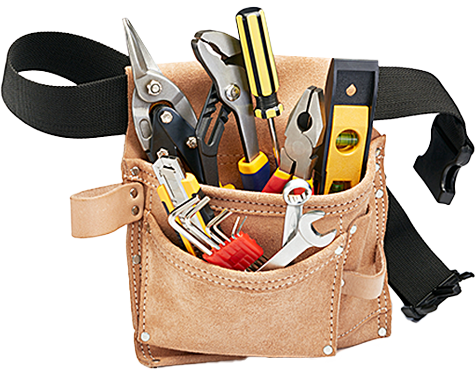Last month, we started building you a toolkit of the plumbing tools you should keep on hand in your home. Then, we kept thinking of ideas until we couldn’t fit all of them in one blog! We needed a part 2. These tools are just as easy to find as the tools in Part 1, and they’re just as important for the prepared homeowner to have handy, too.
If you have these tools and know how to use them, you’ll be ready to make almost any fix a homeowner can. Whether you’re moving to a new home or just looking to update your existing toolkit, these are four more important plumbing tools to invest in.

A “Zip-It” Drain Cleaning Tool
Getting hair out of your drains is one of the great homeowner anxieties. Wet hair tangles and smells in the drain. The process of removing it is unpleasant enough that you put it off, or worse, use some noxious chemical cleaner. Hair in your drain will make your shower, sink, or bathtub less effective and less sanitary. Having an effective means of getting it out is important.
Enter the zip-it. A zip-it is a thin plastic wand measuring approximately 12-20 inches. It’s easy to work the flexible, soft polymer tool into the drain. At the top end there’s a handle for maneuvering the tool. From the handle down, sharp barbs stick out on either side of the wand.
Work the barbed end down into the drain. Move it around to dislodge and grab ahold of hair and other debris. Using the zip-it will only take take you a couple minutes, and you’ll pull out some pretty amazing stuff. Throw the zip-it away after using it. Zip-its usually come in packs of 6 to 24. You can find them at most hardware stores.
Tongue-and-Groove Pliers
Tongue-and-groove pliers go by many names: water pump pliers, adjustable pliers, groove-joint pliers, and so on. They feature slip-joint pliers with serrated jaws and a pair of fixed, long handles. The handles are usually 9.5 to 12 inches long and include grips to improve control and ease of use.
Plumbers adjust tongue-and-groove pliers to grip and turn nuts and bolts from many positions. Plumbers often have to work in awkward positions, so these pliers are a big help.
The plier’s jaws can adjust to different sizes without changing the space between the handles. To adjust, slide the lower jaw along the tracking groove built into the upper jaw. Plumbers use the tongue-and-groove pliers to get at fasteners that might otherwise be out-of-reach. They’re cheap, common, easy to use, and have a huge variety of applications, so they’re a great addition to your plumbing-preparedness kit.

Plumber’s Putty
It’s difficult to install plumbing fixtures like drains without leaving gaps between the sink and fixture. Even the tiniest gap will let water drain out, which is obviously not something you want. The easiest and most effective way to reliably ensure leak-free plumbing is to apply plumber’s putty during installation.
Plumbers use this clay-based sealant by molding it and spread onto surfaces and appliances. During sink installations, for instance, the plumber typically rolls plumber’s putty into a long, thin ring. The installer places the ring is around the circumference of the hole at the sink’s base and presses it into the basin. Then, drain is placed into the putty until it fits snuggly with no gaps between the drain, the putty, and the hole. The putty repels water and fills in gaps between drain and sink, creating a watertight seal that allows no water to leak out of the sink instead of going down the drain.
Virtually all plumbing fixtures that need watertight seals to function properly, like drain lines, faucets, sinks, and valves, require plumber’s putty. It’s one of the most important tools to have around when doing plumbing maintenance or DIY projects of your own. You can find plumber’s putty cheap at any hardware store.

Hex Keys
Commonly called Allen keys or Allen wrenches, hex keys are a set of thin, L-shaped, single-piece metal wrenches of various sizes with hexagonal heads. Plumbers use them to fit six-sided bolts and screws called hex screws. Manufacturers commonly use hex screws in showerheads, garbage disposals, and lots of other plumbing fixtures. They come in a wide variety of sizes to be used in places that are difficult to access, which is why multiple hex keys are required.
The head of the hex key fits into the grooves on the hexagonal screw. You simply grip the straight portion of the wrench and apply the torque required to either loosen or tighten. If you run out of space to rotate the wrench, pull it out and replace it to give yourself leeway. If the tightening or loosening process proves difficult, it’s possible you’re using a wrench that’s too small. To figure out which hex key you should use, start with the smallest and work your way up until you find the right size.
Hex screws are common, so your hex keys will see a lot of use both in plumbing and other home repair projects. They’re cheap, durable, portable, and easy to find at any hardware store.
If you stock your toolbox with these tools, you’ll be prepared to handle just about any plumbing problem that comes your way. When trouble strikes, just remain calm, do a little research (we can help with that, too!), and remember: you’re prepared. And if the trouble turns out to be a bigger than you realized, don’t forget that we’ll always have your back. Good luck with your plumbing projects; you’ve got this.





